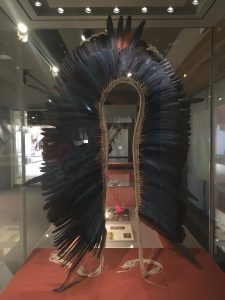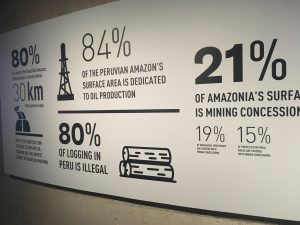As one enters the Amazonia exhibit in the UBC Museum of Anthropology, they read of the balanced relationship between the rainforest and the humans that live within it. The lifestyle of the Indigenous peoples is based upon the ideas of respecting nature and maintaining a deep connection to it. These values serve as a backdrop to the entire exhibit, providing insight into the rainforest’s current status and the issues it faces.
Throughout my time spent at exhibit, I was able to observe many beautiful artifacts from the world’s largest rainforest, as well as learn a great deal about the region’s ancient cultures. As described on the MOA website, there are “unsuspected relationships between Vancouver and Amazonian peoples [and] ideas,” and I found this indeed to be quite accurate.
The object I have chosen to focus on is a headdress from the Kayapo (Mebengokre) people. This dazzling display features hundreds of dark blue feathers, woven together into one traditional garb. Aside from its aesthetically pleasing nature, the headdress represents much more about the people of Kayapo and the connection with Vancouver.

The Headdress from the Kayapo people, UBC Museum of Anthropology
As noted below the artifact, Vancouver residents travelled to Brazil together with a leader from the tribe to help in the fight against the future construction of a hydroelectric dam in their territory. This struggle to save the rainforest and protect native peoples’ lands is an issue that people from Vancouver can relate to, as we face similar ones. The process of reparations is an ongoing one in BC, however the struggles in places such as Brazil appear to be much more urgent with far-reaching repercussions. It is invaluable to have Vancouver residents helping out to try and ensure that injustices do not continue to occur like they have here. This headdress represents this relationship, and thus this is why I chose to focus on it.
I found the large white wall focusing on the industrial side of the Amazon rather interesting for a number of reasons. Firstly, I was quite shocked at many of the statistics I was reading, such as the fact that “84% of the Peruvian Amazon’s surface area is dedicated to oil production,” and that “80% of cases of deforestation in the Brazilian Amazon are found within 30 km from paved roads.”

Statistics regarding the Amazon rainforest, UBC Museum of Anthropology
While I found these facts distressing, I was also considering Canadians’ perspectives when critiquing these issues. The deforestation in British Columbia due to logging is expansive and only continuing to grow. While I understand that facts regarding the Peruvian and Brazilian Amazon are accurate and alarming, it comes across as somewhat hypocritical to be critiquing countries in South America for very similar practices that the forestry industry engages in here. In some sense, this adds to the relationship between the two areas, making it nuanced and more complicated.
One quote that struck me from the pamphlet I collected at the entrance to the exhibit reads as follows: “Everyone had the right to a healthy, protected and balanced environment.” (Constitution of the Plurinational State of Bolivia). This statement embodies the mindset that the people of the Amazon rainforest hold dear: maintaining a prosperous natural world is as fundamental as any other human right. Maybe if more people thought like this, the world would be a better place.